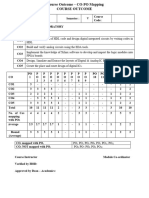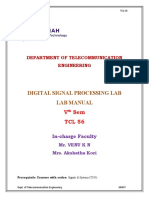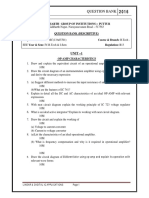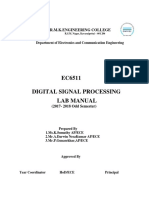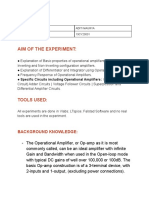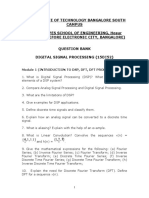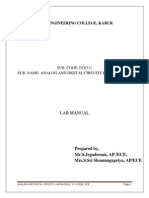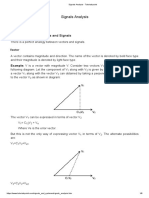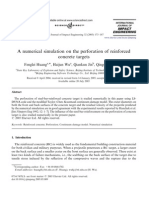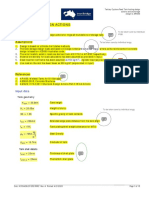SIGNALS ANALYSIS
http://www.tutorialspoint.com/signals_and_systems/signals_analysis.htm
Copyright tutorialspoint.com
Analogy Between Vectors and Signals
There is a perfect analogy between vectors and signals.
Vector
A vector contains magnitude and direction. The name of the vector is denoted by bold face type
and their magnitude is denoted by light face type.
Example: V is a vector with magnitude V. Consider two vectors V 1 and V 2 as shown in the
following diagram. Let the component of V 1 along with V 2 is given by C12 V 2 . The component of a
vector V 1 along with the vector V 2 can obtained by taking a perpendicular from the end of V 1 to
the vector V 2 as shown in diagram:
The vector V 1 can be expressed in terms of vector V 2
V 1 = C12 V 2 + V e
Where Ve is the error vector.
But this is not the only way of expressing vector V 1 in terms of V 2 . The alternate possibilities are:
V 1 =C1 V 2 +V e1
V 2 =C2 V 2 +V e2
�The error signal is minimum for large component value. If C12 =0, then two signals are said to be
orthogonal.
Dot Product of Two Vectors
V 1 . V 2 = V 1 .V 2 cos
= Angle between V1 and V2
V 1 . V 2 =V 2 .V 1
The components of V 1 alogn V 2 = V 1 Cos = V 1.V 2
V2
From the diagram, components of V 1 alogn V 2 = C 12 V 2
V1 . V2
V2 = C1 2 V2
C12 =
V1 . V2
V2
Signal
The concept of orthogonality can be applied to signals. Let us consider two signals f1 t and f2 t .
Similar to vectors, you can approximate f1 t in terms of f2 t as
f1 t = C12 f2 t + fet for (t1 < t < t2 )
fet = f1t C12 f2t
One possible way of minimizing the error is integrating over the interval t1 to t2 .
t2
1
[fe (t)]dt
t2 t1 t1
t2
1
[f1 (t) C12 f2 (t)]dt
t2 t1 t1
However, this step also does not reduce the error to appreciable extent. This can be corrected by
taking the square of error function.
1
t2 t1
1
t2 t1
tt12 [fe (t)]2 dt
tt12 [fe (t) C12 f2 ]2 dt
Where is the mean square value of error signal. The value of C12 which minimizes the error, you
need to calculate d
dC12
d
[ 1
dC12 t2 t1
1
t2 t1
=0
tt12 [f1 (t) C12 f2 (t)]2 dt] = 0
tt12 [ dCd f12 (t)
12
d
dC12
2f1 (t)C12 f2 (t) +
d
dC12
2 ]dt = 0
f22 (t)C12
Derivative of the terms which do not have C12 term are zero.
tt12 2f1 (t)f2 (t)dt + 2C12 tt12 [f22 (t)]dt = 0
t
() ()
�If C12
tt2 f1 (t)f2 (t)dt
1
tt2 f22 (t)dt
component is zero, then two signals are said to be orthogonal.
Put C12 = 0 to get condition for orthogonality.
0=
tt2 f1 (t)f2 (t)dt
1
tt2 f22 (t)dt
1
t2
t1
f1 (t)f2 (t)dt = 0
Orthogonal Vector Space
A complete set of orthogonal vectors is referred to as orthogonal vector space. Consider a three
dimensional vector space as shown below:
Consider a vector A at a point (X 1 , Y 1 , Z 1 ). Consider three unit vectors (V X, V Y, V Z) in the direction
of X, Y, Z axis respectively. Since these unit vectors are mutually orthogonal, it satisfies that
VX . VX = VY . VY = VZ . VZ = 1
VX . VY = VY . VZ = VZ . VX = 0
You can write above conditions as
Va . Vb = {
1
0
a=b
ab
The vector A can be represented in terms of its components and unit vectors as
A = X1 VX + Y1 VY + Z1 VZ . . . . . . . . . . . . . . . . (1)
Any vectors in this three dimensional space can be represented in terms of these three unit
vectors only.
If you consider n dimensional space, then any vector A in that space can be represented as
A = X1 VX + Y1 VY + Z1 VZ +. . . +N1 VN . . . . . (2)
As the magnitude of unit vectors is unity for any vector A
The component of A along x axis = A.V X
The component of A along Y axis = A.V Y
�The component of A along Z axis = A.V Z
Similarly, for n dimensional space, the component of A along some G axis
= A. V G. . . . . . . . . . . . . . . (3)
Substitute equation 2 in equation 3.
CG = (X1 VX + Y1 VY + Z1 VZ +. . . +G1 VG . . . +N1 VN )VG
= X1 VX VG + Y1 VY VG + Z1 VZ VG +. . . +G1 VG VG . . . +N1 VN VG
= G1 since VG VG = 1
If VG VG 1 i.e.VG VG = k
AVG = G1 VG VG = G1 K
G1 =
(AVG )
K
Orthogonal Signal Space
Let us consider a set of n mutually orthogonal functions x1 t , x2 t ... xn t over the interval t1 to t2 . As
these functions are orthogonal to each other, any two signals xjt , xkt have to satisfy the
orthogonality condition. i.e.
t2
t1
xj (t)xk (t)dt = 0 where j k
Let
t2
t1
x2k (t)dt = kk
Let a function ft , it can be approximated with this orthogonal signal space by adding the
components along mutually orthogonal signals i.e.
f(t) = C1 x1 (t) + C2 x2 (t)+. . . +Cn xn (t) + fe (t)
= nr=1 Cr xr (t)
f(t) = f(t) nr=1 Cr xr (t)
Mean sqaure error
1
t2 t2
tt12 [fe (t)]2 dt
n
t2
1
=
[f[t] Cr xr (t)]2 dt
t2 t2 t1
r=1
The component which minimizes the mean square error can be found by
d
d
d
=
=. . . =
=0
dC1
dC2
dCk
Let us consider d
dCk
=0
t2
d
1
[
[f(t) nr=1 Cr xr (t)]2 dt] = 0
dCk t2 t1 t1
All terms that do not contain Ck is zero. i.e. in summation, r=k term remains and all other terms
are zero.
t2
t1
2f(t)xk (t)dt + 2Ck
Ck =
t2
t1
t2
t1
[x2k (t)]dt = 0
tt12 f(t)xk (t)dt
inttt21 x2k (t)dt
f(t)xk (t)dt = Ck Kk
Mean Square Error
The average of square of error function fet is called as mean square error. It is denoted by
epsilon .
.
1
t2 t1
tt12 [fe (t)]2 dt
1
t2 t1
tt12 [fe (t) nr=1 Cr xr (t)]2 dt
1
t2 t1
[tt12 [fe2 (t)]dt + nr=1 Cr2 tt12 x2r (t)dt 2nr=1 Cr tt12 xr (t)f(t)dt
t
You know that Cr2 t 2
1
x2r (t)dt = Cr tt12 xr (t)f(d)dt = Cr2 Kr
1
t2 t1
[tt12 [f 2 (t)]dt + nr=1 Cr2 Kr 2nr=1 Cr2 Kr ]
1
t2 t1
[tt12 [f 2 (t)]dt nr=1 Cr2 Kr ]
1
t2 t1
[tt12 [f 2 (t)]dt + (C12 K1 + C22 K2 +. . . +Cn2 Kn )]
The above equation is used to evaluate the mean square error.
Closed and Complete Set of Orthogonal Functions
Let us consider a set of n mutually orthogonal functions x1 t , x2 t ...xn t over the interval t1 to t2 . This
is called as closed and complete set when there exist no function ft satisfying the condition
tt12 f(t)xk (t)dt = 0
If this function is satisfying the equation t 2 f(t)xk (t)dt = 0 for k = 1, 2, . . then ft is said to be
1
orthogonal to each and every function of orthogonal set. This set is incomplete without ft . It
becomes closed and complete set when ft is included.
ft can be approximated with this orthogonal set by adding the components along mutually
orthogonal signals i.e.
f(t) = C1 x1 (t) + C2 x2 (t)+. . . +Cn xn (t) + fe (t)
If the infinite series C1 x1 (t) + C2 x2 (t)+. . . +Cn xn (t) converges to ft then mean square error is
zero.
Orthogonality in Complex Functions
If f1 t and f2 t are two complex functions, then f1 t can be expressed in terms of f2 t as
f1 (t) = C12 f2 (t)
..with negligible error
�Where
C12 =
tt2 f1 (t)f2 (t)dt
1
tt2 | f2 (t)|2 dt
1
Where f2 (t) = complex conjugate of f2 t .
If f1 t and f2 t are orthogonal then C12 = 0
tt12 f1 (t)f2 (t)dt
tt12 |f2 (t)|2 dt
t2
t1
=0
f1 (t)f2 (dt) = 0
The above equation represents orthogonality condition in complex functions.














